Kazimir Malevich – The Founder of the Suprematism Movement
The pioneering literature and artworks of Kazimir Malevich profoundly influenced the development of 20th-century Abstract and non-objective art. Kazimir Malevich’s paintings, such as his Black Square painting, illustrated his concept of Suprematism, which aimed to develop a unique art form that explored spirituality and the “supremacy of pure feeling” by moving away from objective subject matter and forms. Along with the works of artists such as Sonia Delaunay, Alexander Archipenko, and David Burliuk, Malevich’s artworks were labeled as Ukrainian Avant-Garde art, which had been influenced by artists that had initially produced art in Ukraine and then extended to regions such as America and Europe. While the artist was known to have assimilated Symbolism, Fauvism, and Impressionism into his work, he would progressively simplify his style, leading to bold pieces such as his Red Square painting.
The Life and Art of Kazimir Malevich
| Name | Kazimir Malevich |
| Nationality | Russian |
| Date of Birth | 26 February 1879 |
| Date of Death | 15 May 1935 |
| Place of Birth | Kyiv, Ukraine |
It was not just Malevich’s paintings that brought him renown, he was also a prolific and respected author who addressed various theoretical art issues, especially the power of Non-objective art to transcend the viewer to a spiritual realm. Kazimir Malevich’s artworks were famous examples of the abstract and flat painting style characteristic of the Suprematist aesthetic, thought to convey those spiritual feelings through multi-layered symbolism.
Through his Western connections, he was able to convey his concepts to artists in the United States and Europe, thereby having a profound effect on the development of Modern art.
Early Life
During the partitions of Poland, Malevich’s family moved to a region near Kyiv, which was then part of the Russian Empire. They fled from a region that is now Belarus, following the failure of the Polish Uprising of 1863. Due to these circumstances, he was able to speak Russian and Ukrainian, in addition to his native Polish. Most of his youth was spent in the sugar-beet plantations of various villages, and he would not even know about professional artists until he was around 12 years of age.
However, it was around this time that he decided to pursue a career as an artist, and he trained at a succession of various institutions, commencing in 1895 at the Kyiv School of Art.
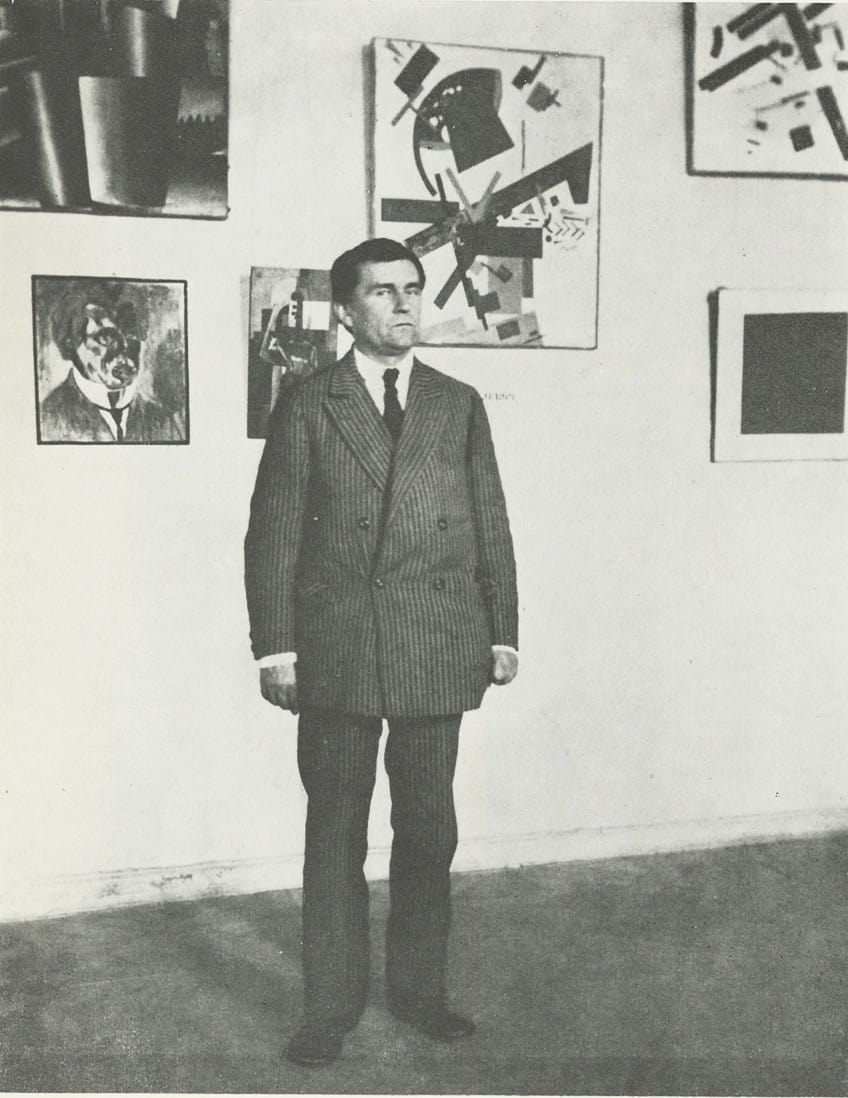
Following his father’s passing in 1904, he relocated to Moscow to train further at the Stroganov School of Art. The renowned art instructor, Ivan Rerberg, also instructed him privately. Artists such as Konstantin Korovin and Leonid Pasternak taught him the painting techniques of various movements such as Impressionism and post-Impressionism at the Moscow School of Painting, Sculpture, and Architecture. While the influence of post-Impressionism is evident in early Malevich paintings, Art Nouveau and Symbolism were equally significant in his early development.
Mature Period
Newly made acquaintances such as David Burliuk, Wassily Kandinsky, and Mikhail Larionov started to have a significant influence on Malevich’s art, as it began to steer towards a more Avant-Garde aesthetic. He was then invited to join Larionov’s exhibition, Jack of Diamonds, in 1910. His interest in art spanned many styles, though, and he was also a member of art groups that focused on the philosophies of movements such as Futurism, Cubism, and Primitivism. Kazimir Malevich then assumed a leading position in the Youth Union in Saint Petersburg following an argument with Larionov.
Scenes of regional peasant life became the main focus of Malevich’s paintings in this period. Malevich was able to produce dynamic geometrically deconstructed figures in space by combining elements of Italian Futurism and Synthetic Cubism with his primarily Cubo-Futurist style.
An exhibition of Aristarkh Lentulov’s works, which took place in Moscow in 1913, would turn out to be significant in regard to its effect on the artists of the Russian Avant-Garde movement, including the work of Malevich, who all adopted the principles of Cubism. The set designs co-created by Malevich in 1913 for the opera Victory over the Sun, were the result of one of the most notable artistic collaborations of the Modern art era. In 1915, Malevich turned to pure abstraction by eschewing figurative elements, laying down the fundamental principles of Suprematism in his manifesto From Cubism to Suprematism. A new chapter in Malevisch’s career began following the October Revolution in 1917.
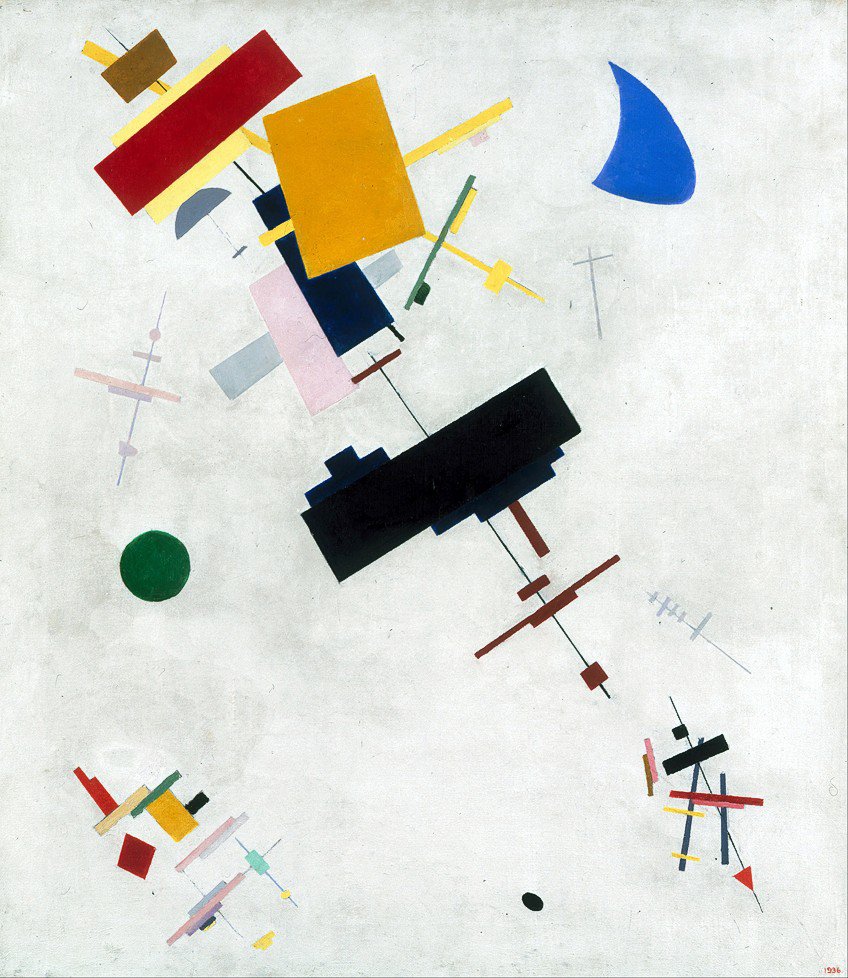
Malevich then joined the Fine Arts Department of the People’s Commissariat in 1918, which was to administer museums as well as facilitate the new Soviet Republic’s art education department. He also tutored at Moscow’s Free Art Studios, telling his students to turn away from the representational aesthetics favored by the bourgeois, in favor of radical abstraction. In 1919.
Kazimir Malevich sought to apply Suprematism’s theories to the new order of the state by promoting the utilization of Avant-Garde artworks in service of the state and its citizens in his manuscript On New Systems in Art. However, he would subsequently relocate to Vitebsk to tutor at an art school run by Marc Chagall.
Upon Chagall’s departure from Vitebsk (or some argue, due to the rising popularity of Malevich within the school), Malevich would become the leading figure within the institution. He then formed a collective of artists known as UNOVIS, in which no one artwork was signed by an individual artist, but rather with the name of the collective.
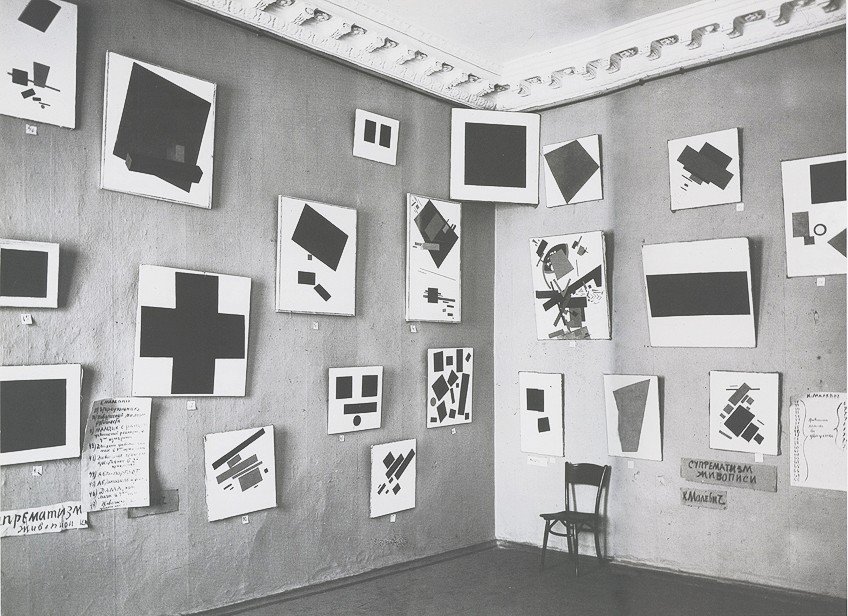
Similar to the German Bauhaus School, the collective steered away from traditional techniques, focusing their attention on the production of signposts, textile patterns, china products, and street decorations. He also designed “Architectona” – architectural model prototypes of utopian cities, subsequently taking them to showcase at German and Polish exhibitions, where they were received with interest and enthusiasm by local intellectuals and artists. Along with many of Malevich’s artworks and manuscripts, several of these models were left in Germany following his swift exit to Russia.
It was there, however, that he soon came to realize that the 1920s artistic blossoming had been cut short by the emergence of Socialist Realism art sponsored by the state which would come to suppress and dominate over all existing styles of art.
Late Years and Death
Kazimir Malevich’s paintings had little chance of thriving in such restrictive and conservative circumstances. Upon returning from his trip to the West in 1930, he was detained and questioned about his personal ideological beliefs. Upon his arrest, his friends burned many of his manuscripts as a safety precaution. To commemorate the Bolshevik Revolution’s 15th anniversary, the state endorsed a large art exhibition. Although included in the exhibit, Malevich’s paintings now featured slogans that were considered anti-Soviet and degenerate.
He would eventually return to themes of peasant life and portraiture following the banning of his works from exhibitions and schools in his later years.

In 1935, he passed away and was interred in a coffin that he had personally designed, featuring the famous Black Square painting on the coffin’s lid. It would only be in 1988, under the rule of Gorbachev, that Kazimir Malevich’s paintings were once again displayed to the public, after being relegated to Soviet Museum basements for so many years.
Kazimir Malevich’s Lasting Legacy
Although he had developed the concept of Suprematism just before the Revolution in 1917, its principles were already adopted by many within the Russian Avant-Garde. His focus on dynamic and geometric forms and Non-objective artworks were highly influential on artists such as El Lissitzky, Alexander Rodchenko, and Lyubov Popova.
Following the emergence of Socialist Realism, many of his ideas were pushed underground, or resurfaced overseas as he showcased his utopian city models to eager audiences.

Many European artists were also influenced by his works following his one and only trip to the West in 1927, where his works were displayed in Amsterdam’s Stedelijk Museum. His monochrome works were also known to be influential with those who had encountered him at Vitebsk. The influence of his style can be seen in many subsequent abstract artists from the United States and Europe.
Kazimir Malevich’s Artworks
That same year, he first exhibited his Black Square painting in Petrogard at the Last Futurist Exhibition. In 1923 he painted another rendition, followed by a third in 1929, which many believe was produced to replace the 1915 version due to its poor condition. A final version was created in 1932, perhaps to serve as a diptych to the Red Square painting. Both of the paintings would serve as the show’s centerpiece.
Milda Victurina, an art historian and radiologist, has studied and analyzed Malevich’s paintings and has made certain observations about his painting technique, such as his technique of layering colors to produce various color spots.

For instance, for red spots, he would layer black at the bottom and red at the top, resulting in a darker hue perceived by the observer once rays of light go through and bounce back from the various layers. This layering technique was unique to his works and was the first thing experts would look for when analyzing potential fakes. Here are a few famous examples of Kazimir Malevich’s paintings.
| Artwork Title | Date | Medium | Dimensions (cm) | Location |
| The Reaper | 1913 | Oil on canvas | 13.8 x 13 | The Fine Arts Museum, Nizhnij Novgorod, Russia |
| Woman With Pails: Dynamic Arrangement | 1913 | Oil on canvas | 80 x 80 | The Museum of Modern Art, New York City, United States |
| Black Square | 1915 | Oil on canvas | 80 x 80 | Tretyakov Gallery, Moscow, Russia |
| Airplane Flying | 1915 | Oil on canvas | 58 x 48 | The Museum of Modern Art, New York City, United States |
| Self-Portrait | 1933 | Oil on canvas | 27 x 26 | Russian Museum, St. Petersburg, Russia |
Posthumous Exhibitions
Following his passing, Kazimir Malevich’s artworks were posthumously featured in several exhibitions, such as in 1936, when Alfred H. Barr Jr. featured several of his works at the Museum of New York in the Cubism and Abstract Art exhibition. Malevich’s paintings embodied certain aesthetic ideals found within the Russian Avant-Garde movement that would inspire Solomon R. Guggenheim to found the Museum of Non-Objective Painting in 1939.
His influence on European and American artists would further be increased following the first retrospective of his work at the Guggenheim Museum in 1973. Unfortunately, most of Malevich’s art would remain hidden away from public view until a period of transparency and reformation occurred in Russian politics.
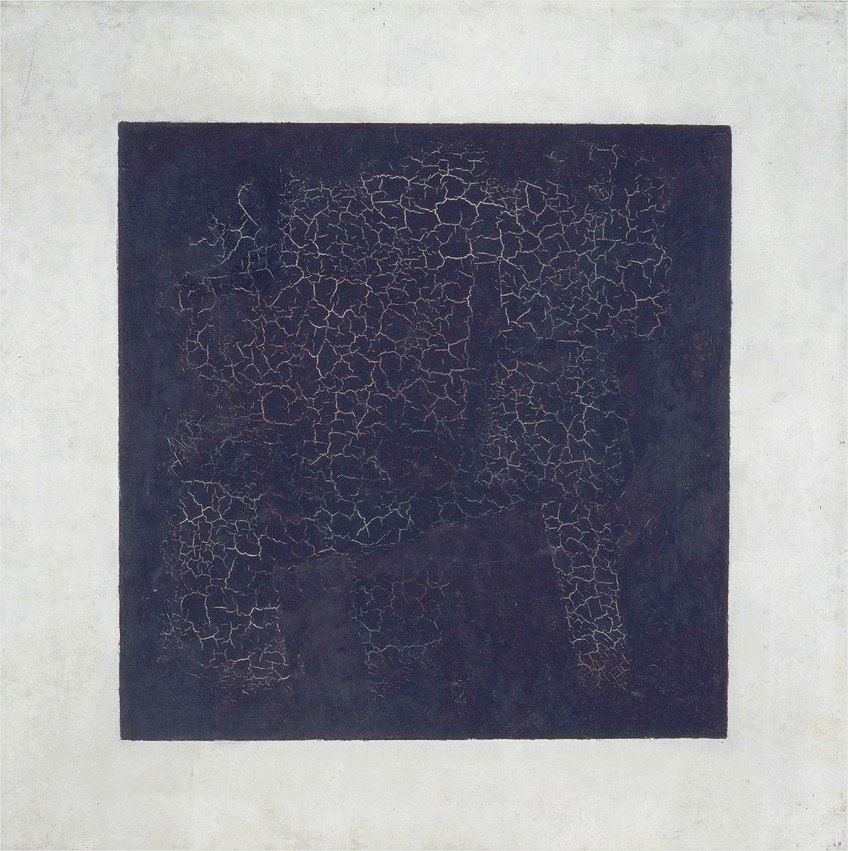
The first large-scale retrospective of his works took place at the Stedelijk Museum in Amsterdam in 1989, featuring works that they already owned as well as those from the collection of Nikolia Khardzhiev, an art critic from Russia. Today, Kazimir Malevich’s paintings can be found in many permanent exhibitions around the world, with works featured in renowned institutions such as the aforementioned Stedelijk Museum, the Guggenheim Museum, and the Museum of Modern Art in New York. The State Museum of Contemporary Art in Thessaloniki also has a notable collection of Malevich’s paintings, as does the State Tretyakov Gallery in Moscow, Russia.
Art Market
In 1993, the fourth rendition of the Black Square painting was discovered in Samara, and subsequently bought for $250,000, and then auctioned in 2002 for the equivalent of one million dollars. Five of Malevich’s artworks, which he had left in Berlin upon his hasty exit, and which the Stedelijk Museum had subsequently acquired, were given back to the Malevich family heirs in 2008, on condition that the museum be given the authorized title of the remaining works.
One of these artworks would eventually end up selling for more than $60 million at a Sotheby’s auction on the 3rd of November 2008. Titled Suprematist Composition (1916), it set a new annual record for any Russian artwork sold at auction. It then sold again for $85 million in 2018.
Kazimir Malevich’s Artistic Concepts and Beliefs
While many people might not fully understand the abstract nature of Malevich’s artwork, his writings reveal that the abstract visual language of his works were underpinned by complex theories and principles. Others revere him on an almost mystical level, due to his expansive knowledge of speculative and philosophical literature.
He even speculated about concepts such as the fourth dimension, yet it was the works of the poets Khlebnikov, Kruchenykh, and Roman Jakobson, the Russian formalist, who would significantly influence his way of thinking. With these individuals, he found a shared desire to blow up the conventions of logic to try and discover a new way of understanding reality.
Artists such as Mikhail Larionov and Natalia Goncharova were responsible for reigniting his love for folk art as well as his belief in the intrinsic power of symbols and icons. The simplistic and blunt nature of his Suprematism works can be traced back to the direct expression characteristic of folk art. As both a teacher and artist, he sought to disrupt what he considered to be a bourgeois grip on the art world. In an ironic turn of events, Malevich’s paintings would later be labeled bourgeois by the soviet state when Socialist Realism dominated the artistic landscape in that region.

Yet, few were more driven than he was to cast aside centuries of Renaissance ideals in pursuit of a new paradigm. For him, the Renaissance principles resulted in works that were nothing but merely aesthetically pleasing, and only Suprematism could offer something original with deeper meanings concealed in its content. His disciples will even state that he exceeded Matisse and Picasso in his artistic efforts. As far as they had managed to push the depiction of reality, he had abandoned all notions of figurative representation in favor of purely non-objective art styles.
Why Kazimir Malevich’s Paintings Were Banned
Upon Malevich’s arrival in Warsaw in 1927, he was met with open arms by the local art community. While there, he met up with former students Katarzyna Kobro and Władysław Strzemiński, who were highly influenced by his style and writings, evident in their own movement – Unism. The Polonia Palace Hotel would serve as the venue for his first foreign exhibition. International recognition was finally achieved following successful retrospectives in Munich and Berlin. It was then arranged that the majority of his works would remain in the country upon his return to the Soviet Union. He had developed certain assumptions that Stalin’s incoming regime would eventually turn against modern art, and this turned out to be true just a few years later.
Any artwork that was not regarded by the state as expressing “reality” were deemed “degenerate” and consequently, many of his works were confiscated, and he was prohibited from producing or exhibiting any works of that nature. The threats against him and his art were hardly idle, though.
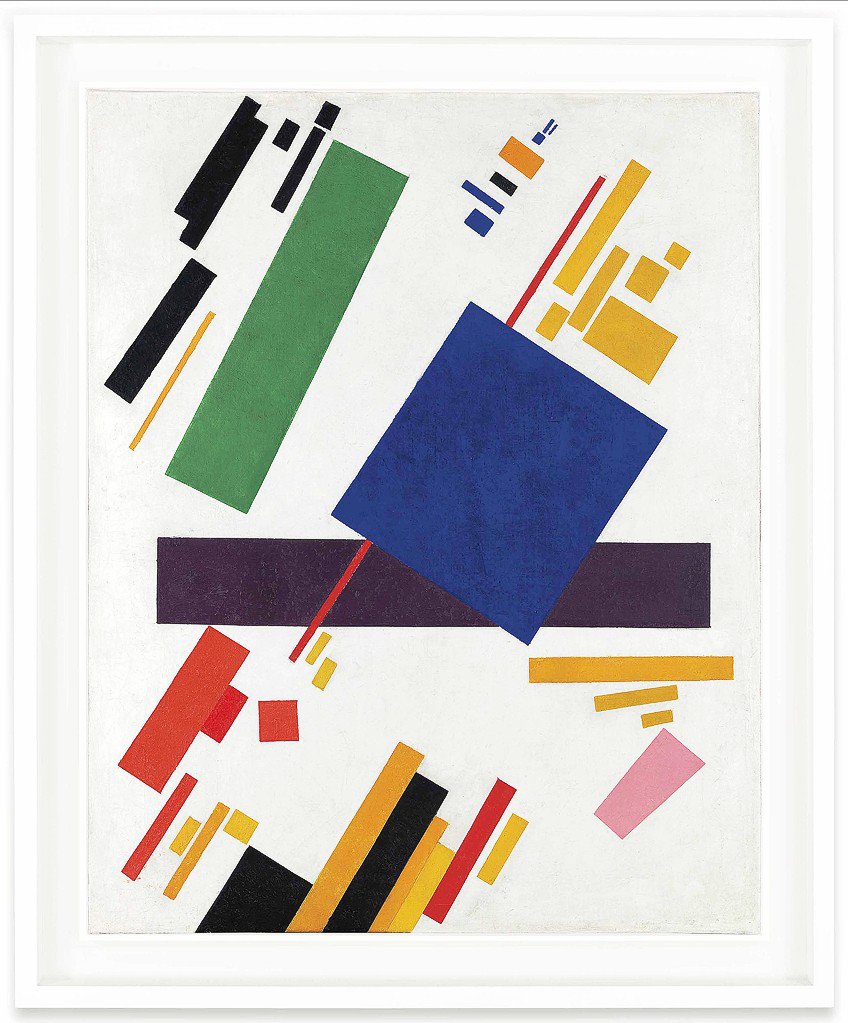
The KGB even took him away and interrogated him in 1930, accusing him of espionage, as well as threatening him with torture and execution. However, he was eventually released in December of that same year. His biggest critics stated that his works were created in contempt of everything pure and good in the world: love of nature and love itself, such as Alexandre Benois. Malevich replied to that statement by saying that art was capable of advancing for the sale of art alone.
As we have learned today, Kazimir Malevich’s artworks were highly regarded for the role they played in shifting the perspectives of many artists, eventually resulting in the sire of modern art movements that abandoned the figurative style of producing in favor of the non-objective art style that he promoted. It was not just through his art that he reached such a wide audience, but also through his many publications that called for a new paradigm that would shatter the old ways of mere aesthetic representation, so that a style could emerge that sought to express something closer to a spiritual experience. This would ultimately prove difficult, given the restrictive environment from which he created, yet the seed had already been planted throughout Europe and the United States through his many exhibitions, both retrospective and posthumous.
Take a look at our Kazimir Malevich paintings webstory here!
Frequently Asked Questions
Who Was Kazimir Malevich?
Kazimir Malevich was a renowned artist and theoretician from Russia. Malevich’s artwork is most known for its representation of the Suprematism style, which he had personally developed, and which is characterized by the utilization of a limited color palette and basic geometric shapes. Due to his art and writing, he is regarded by many to be one of the figures that pushed the development of Abstract art to new heights.
Why Are Kazimir Malevich’s Paintings Important?
Kazimir Malevich’s artworks were influential in the development of Abstract art, and his Black Square painting from 1915 is regarded as one of the very first examples of pure abstract painting. This means that it symbolizes a rather important moment in the history of modern art. Along with the other artists of the Russian Avant-Garde movement, Malevich wanted to sever ties with the conventional art styles in search of something revolutionary and unique. Due to the time in which they were created, Malevich’s artworks also act as reflections of the political, social, and cultural climate of that region – a place where non-objective art was increasingly viewed as a threat to the Realism style that was being pushed by the state.
Why Were Kazimir Malevich’s Artworks Banned?
The Soviet state had decided that artworks such as those produced by Malevich were anti-state, bourgeois, and formalist. The state was only interested in permitting works that pushed their agenda and socialist ideals. They felt that the abstract nature of his works was too far removed from the depiction of Socialist Realism, and were therefore deemed a threat. It was not just Malevich’s paintings that were under scrutiny, though, and any artist who was a part of the Russian Avant-Garde movement was treated like criminals or traitors. At one point, he was even taken away by members of the KGB, and was heavily interrogated and accused of being a spy. They even went as far as to threaten him with execution! However, since his passing, and shifting attitudes in creative freedom, many of his works can now be found in museums across the world. The style of his works towards the end of his life returned to themes of peasant life, as well as portraits of his friends and family members.
Liam Davis is an experienced art historian with demonstrated experience in the industry. After graduating from the Academy of Art History with a bachelor’s degree, Liam worked for many years as a copywriter for various art magazines and online art galleries. He also worked as an art curator for an art gallery in Illinois before working now as editor-in-chief for artfilemagazine.com. Liam’s passion is, aside from sculptures from the Roman and Greek periods, cave paintings, and neolithic art.
Learn more about Liam Davis and about us.
Cite this Article
Liam, Davis, “Kazimir Malevich – The Founder of the Suprematism Movement.” artfilemagazine – Your Online Art Source. September 22, 2023. URL: https://artfilemagazine.com/kazimir-malevich/
Davis, L. (2023, 22 September). Kazimir Malevich – The Founder of the Suprematism Movement. artfilemagazine – Your Online Art Source. https://artfilemagazine.com/kazimir-malevich/
Davis, Liam. “Kazimir Malevich – The Founder of the Suprematism Movement.” artfilemagazine – Your Online Art Source, September 22, 2023. https://artfilemagazine.com/kazimir-malevich/.



